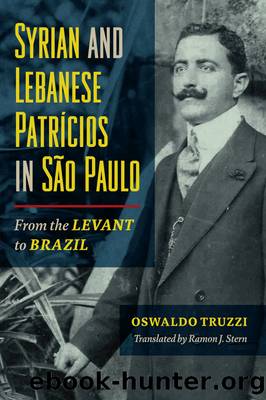Syrian and Lebanese Patricios in Sao Paulo by Oswaldo Truzzi

Author:Oswaldo Truzzi [Truzzi, Oswaldo]
Language: eng
Format: epub
Tags: Social Science, General, Emigration & Immigration, History, Latin America, South America, Middle East
ISBN: 9780252050664
Google: YsRqDwAAQBAJ
Barnesnoble:
Publisher: University of Illinois Press
Published: 2018-08-30T00:00:00+00:00
FIGURE 18. Dr. Wadih Safady, ca. 1920. Courtesy of Clodette Safady Saad Hossne.
Said Abu Jamra may have been the first doctor of Arab origin to practice in Brazil. A graduate of the American University of Beirut, the twenty-eight-year-old arrived in São Paulo in 1899 and set up an office on Rua Florêncio de Abreu, where he cared for Brazilâs first Syrian and Lebanese immigrants. As an educated pioneer, he became an adviser to his patrÃcios. He also became involved in the Syrian nationalist movement and in 1903 founded Al-Afkar, a newspaper that he published for the next forty years. His stature in São Pauloâs Syrian-Lebanese community resulted more from his activities as a journalist and intellectual than from his medical practice, and he served as president of the cityâs chapter of the American University of Beirut Alumni Association. He maintained constant contact with the Syrian intellectual community, and in 1926 he was elected a member of the Academy of Letters in Damascus.20
Fadlo Haidar and Alexandre Yazbek were part of a later generation of Levantine doctors in São Paulo. Haidar obtained his degree, interned as a surgeon in Paris, and arrived in Brazil around 1920. He went on to establish one of the cityâs largest clinics and served as president of the local chapter of the American University of Beirutâs Alumni Association. Yazbek was a member of the first graduating class of the School of Medicine of São Paulo in 1919. The previous year, while still a medical student, he had worked with aid groups to combat the Spanish influenza outbreak. For many years, he operated a practice on Rua Florêncio de Abreu.21
A contemporary of Haidar and Yazbek, Damascus native Chucri Zaidan had just graduated from the American University of Beirut when he was incorporated into the Turkish army as a medical official when the First World War broke out. Taken prisoner by the British, he served as a doctor with their army in Egypt until 1920, when he returned to the Syrian capital. In 1925, he joined his brothers in São Paulo. At his urging, his oldest nephew, Jorge Zaidan, studied medicine, graduating in 1935 and becoming a surgeon, complementing Chucri Zaidanâs practice as a general clinician. The elder Zaidan was noted for treating not only members of the Syrian-Lebanese community but also individuals of other ethnic minorities: during the war, he had learned more than a dozen languages, including Armenian and Russian.22
⢠⢠â¢
Like Alfredo Mathias, Paulo Camasmie was a son of a prosperous Levantine immigrant who went on to a noted engineering career. A 1934 graduate of the Escola Politécnica, Camasmie designed and built numerous structures throughout Brazil, including the Orthodox Cathedral in the ParaÃso neighborhood of São Paulo; the orthodox cathedrals in Curitiba and BrasÃlia; the Muslim mosque on São Pauloâs Avenida do Estado; São Pauloâs Muslim school; the Syrian Sanatorium; and various Syrian and Lebanese clubs and other edifices across the interior of São Paulo state. He also worked for the Jafet family, and built installations for General Mining of Brazil in Mogi das Cruzes.
Download
This site does not store any files on its server. We only index and link to content provided by other sites. Please contact the content providers to delete copyright contents if any and email us, we'll remove relevant links or contents immediately.
| Bahrain | Egypt |
| Iran | Iraq |
| Israel & Palestine | Jordan |
| Kuwait | Lebanon |
| Oman | Qatar |
| Saudi Arabia | Syria |
| Turkey | United Arab Emirates |
| Yemen |
Empire of the Sikhs by Patwant Singh(23020)
The Wind in My Hair by Masih Alinejad(5056)
Rise and Kill First by Ronen Bergman(4739)
The Templars by Dan Jones(4656)
The Rape of Nanking by Iris Chang(4165)
12 Strong by Doug Stanton(3525)
Blood and Sand by Alex Von Tunzelmann(3164)
Babylon's Ark by Lawrence Anthony(2648)
The History of Jihad: From Muhammad to ISIS by Spencer Robert(2599)
No Room for Small Dreams by Shimon Peres(2343)
The Turkish Psychedelic Explosion by Daniel Spicer(2330)
Inside the Middle East by Avi Melamed(2325)
Gideon's Spies: The Secret History of the Mossad by Gordon Thomas(2319)
Arabs by Eugene Rogan(2279)
The First Muslim The Story of Muhammad by Lesley Hazleton(2245)
Come, Tell Me How You Live by Mallowan Agatha Christie(2228)
Bus on Jaffa Road by Mike Kelly(2123)
Kabul 1841-42: Battle Story by Edmund Yorke(2003)
1453 by Roger Crowley(1994)
